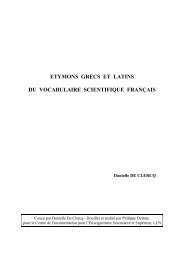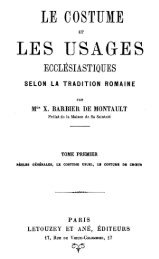The Etymologies of Isidore of Seville - Pot-pourri
The Etymologies of Isidore of Seville - Pot-pourri
The Etymologies of Isidore of Seville - Pot-pourri
You also want an ePaper? Increase the reach of your titles
YUMPU automatically turns print PDFs into web optimized ePapers that Google loves.
342 XVII.vi.19–vii.3 <strong>Isidore</strong> <strong>of</strong> <strong>Seville</strong><br />
springs up from a root; a branch, from the woody part <strong>of</strong><br />
atree;atwig(virga), from a branch. Properly, however,<br />
what grows up at the root <strong>of</strong> a tree and is lopped <strong>of</strong>f as<br />
useless by farmers is called a sucker. It is called virgultum<br />
because it is ‘removed from a twig’ (ex virga tollere). A<br />
twig (virga)issonamed[moreover from ‘vigor’ (vis)] or<br />
from ‘strength’ (virtus) because it contains a great deal<br />
<strong>of</strong> vigor, or from ‘greenness’ (viriditas), or because it is a<br />
symbol <strong>of</strong> peace (i.e. as a lictor’s rod), because it controls<br />
force (vis). For this reason magicians use wands (virga)<br />
to make serpents calm towards each other, and therefore<br />
they hold them up tied to a wand (cf. the caduceus;<br />
see VIII.xi.47 and the footnote there). Indeed, philosophers,<br />
kings, teachers, messengers, and envoys use<br />
wands.<br />
19. Switches(flagellum), as I said above (v.8 above),<br />
are the highest parts <strong>of</strong> trees, because they sustain the<br />
repeated blasts (flatus)<strong>of</strong>wind.20.Acyme (cyma)isso<br />
called as if the word were ‘hair’ (coma). A leaf (folium)<br />
is called in Greek, and this name was carried<br />
over to our language by borrowing. 21.Flowers (flos, pl.<br />
flores)are so called because they quickly drop (defluere)<br />
from trees, as if the word were fluores, for they are quickly<br />
released. <strong>The</strong>se are doubly pleasing: in color and in scent.<br />
<strong>The</strong>y are wilted by the south wind, produced by the<br />
west wind. 22. Wecallafertile, swelling growth a bud<br />
(germen), from ‘bearing’ (gerere); whence also the term<br />
‘germination’ (germinatio). 23. Produce(fructus) takes<br />
its name from frumen, that is, the higher part <strong>of</strong> the<br />
throat, through which we ingest. Whence also ‘crops’<br />
(frux). Properly speaking, produce is what comes from<br />
fields and trees, especially what we make use <strong>of</strong>, but we<br />
speak <strong>of</strong> ‘produce’ with regard to animals incorrectly and<br />
metaphorically.<br />
24. Fruit (pomum) is named from ‘abundant’<br />
(opimus), that is from the abundance <strong>of</strong> its fruitful<br />
growth. Fruits are called ripe (maturus)because they are<br />
ready for eating (mandere); likewise, unripe (immaturus),<br />
because before they become ripe they are too hard<br />
for eating. 25. Firewood (lignum) issocalled because<br />
when kindled it is converted into light (lumen). Whence<br />
likewise the lamp (lichnium)issocalled, because it gives<br />
light (see vii.65 below). 26. Asplinter (astula) isnamed<br />
from ‘raising’ (tollere)[as if it were ‘split away’ (abstula)].<br />
Tinder (fomes)iscomposed <strong>of</strong> splinters that are cast <strong>of</strong>f<br />
from trees by lopping, or charred shavings, or hollowedout<br />
firewood. It takes its name from ‘dried fungus’<br />
(fungus), because they catch fire in the same way. Of<br />
these, Vergil says (Aen. 1.176):<br />
And hestruck flame in the tinder (fomes).<br />
27. Afire-brand (torris) isaburntpiece<strong>of</strong>wood,commonly<br />
called titio, taken from the hearth half-burnt and<br />
with the fire out. 28.Sweepings(quisquiliae)arestubble<br />
mixed with branches and dry leaves; they are the rubbish<br />
<strong>of</strong> the land. Rot (caries) isthedecayedmatter <strong>of</strong> wood,<br />
called this because it occurs in wood that lacks (carere)<br />
solidity.<br />
vii. Specific names <strong>of</strong> trees (De propriis nominibus<br />
arborum) 1. <strong>The</strong> palm (palma) issocalled because<br />
it adorns the hand <strong>of</strong> a conqueror, or because it has<br />
branches spread out in the manner <strong>of</strong> a human palm<br />
(palma). This tree is the symbol <strong>of</strong> victory, with high<br />
and handsome growth, clothed in long-lasting fronds,<br />
and retaining its leaves without any succession <strong>of</strong> foliage.<br />
<strong>The</strong> Greeks call it the phoenix (i.e. )because it lasts<br />
for a long time, after the name <strong>of</strong> that bird <strong>of</strong> Arabia that<br />
is thought to live for many years. Although it grows in<br />
many places, its fruit does not ripen in them all, but<br />
it <strong>of</strong>ten does in Egypt and Syria. Its fruits are called<br />
‘dates’ (dactylus;cf.,“finger”) from their similarity<br />
to fingers. <strong>The</strong> names <strong>of</strong> the dates vary: some are<br />
called palmulae, similar to the ben-nut (myrobalanus);<br />
some <strong>The</strong>ban, which are also called Nicolaian; some<br />
nucales,which the Greeks call (cf. ,<br />
“date-palm”).<br />
2. Laurel (laurus) issocalled from the word ‘praise’<br />
(laus, gen.laudis), because with it the heads <strong>of</strong> conquerors<br />
were crowned with praises. Among the ancients,<br />
moreover, it was named laudea; afterwards, with the letter<br />
d removed and r substituted it was called laurus –just<br />
like auricula (“ear”), which originally was pronounced<br />
audicula, and medidies,whichisnow pronounced meridies<br />
(“midday”). <strong>The</strong> Greeks call this tree ,because<br />
it never loses its verdure; for this reason conquerors are<br />
aptly crowned with it. It is commonly believed that only<br />
this tree is never struck by lightning.<br />
3.<strong>The</strong> apple-tree (malum) 6 is so called by the Greeks<br />
because its fruit is the roundest <strong>of</strong> all fruits (cf. ,<br />
6 Latin classes several fleshy tree-fruits under the term malum,<br />
including quince, pomegranate, peach, citron, etc. See section 22<br />
below.

















